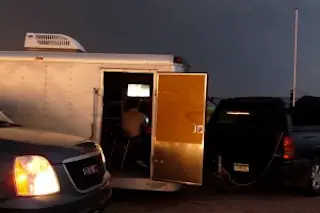Tim Samaras's trailer. Photo by George Johnson During the past three years, while I was doing almost nothing but researching and writing my book about the science of cancer, I was happy to be pulled away for two unexpected diversions: a magazine assignment that sent me to an archaeological site in India (the story has not yet appeared) and another that had me chasing the majestic thunderstorms that, late every summer, sweep across the Southwest. I was riding shotgun with Tim Samaras, an engineer and explosives expert who was intent on capturing an image never before recorded: the moment when an upstroke of charged particles, rising from the ground, meets with a downstroke from the sky and produces a flash of lightning. This happens far too quickly for even the fastest commercial highspeed cameras (the kind used for time lapse photography), so Samaras was hauling around a customized relic (it ...
In the Land of Lightning
Explore the captivating journey of Chasing Lightning with Tim Samaras, aiming to capture lightning's mysterious moments.
More on Discover
Stay Curious
SubscribeTo The Magazine
Save up to 40% off the cover price when you subscribe to Discover magazine.
Subscribe













